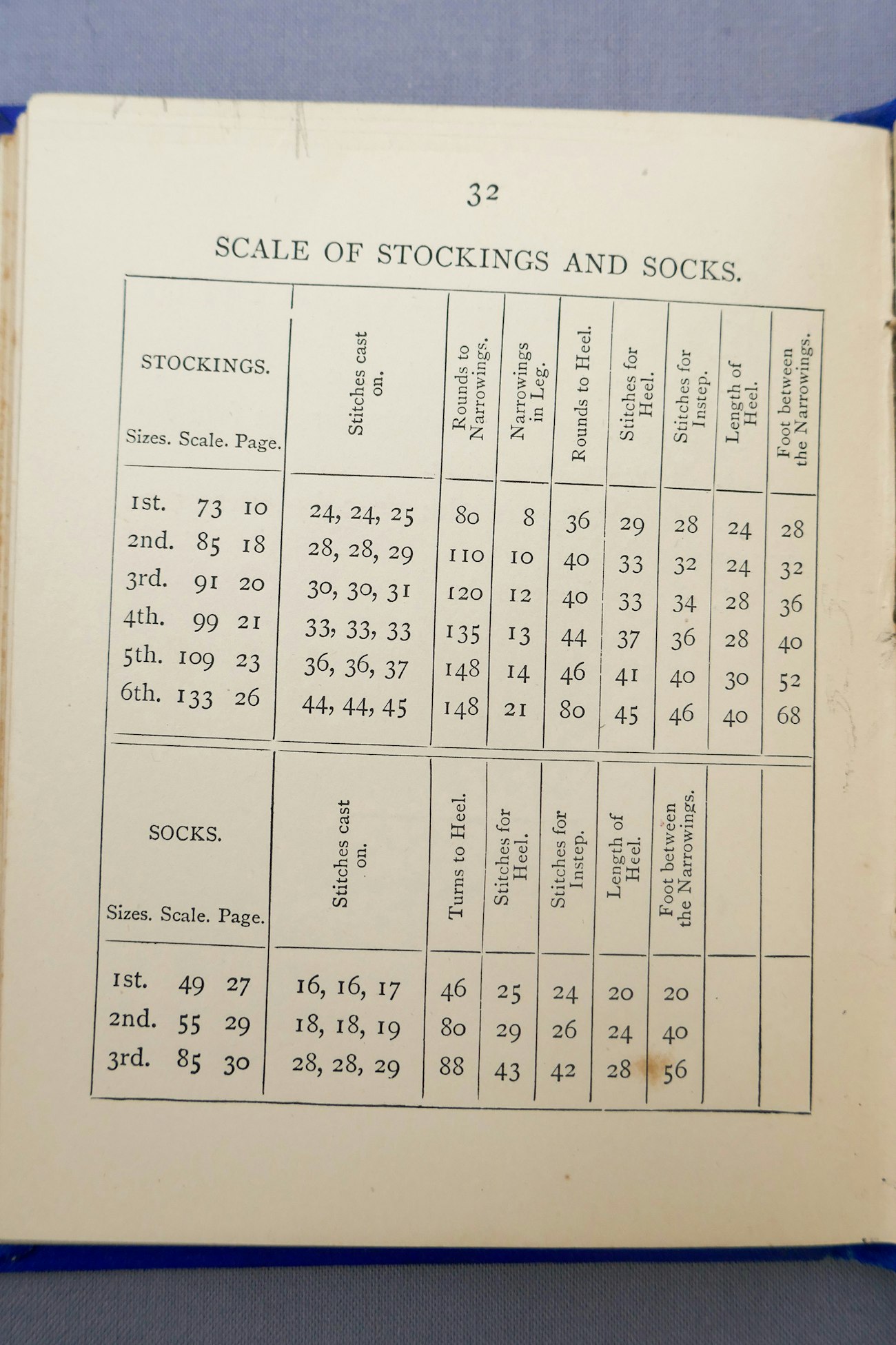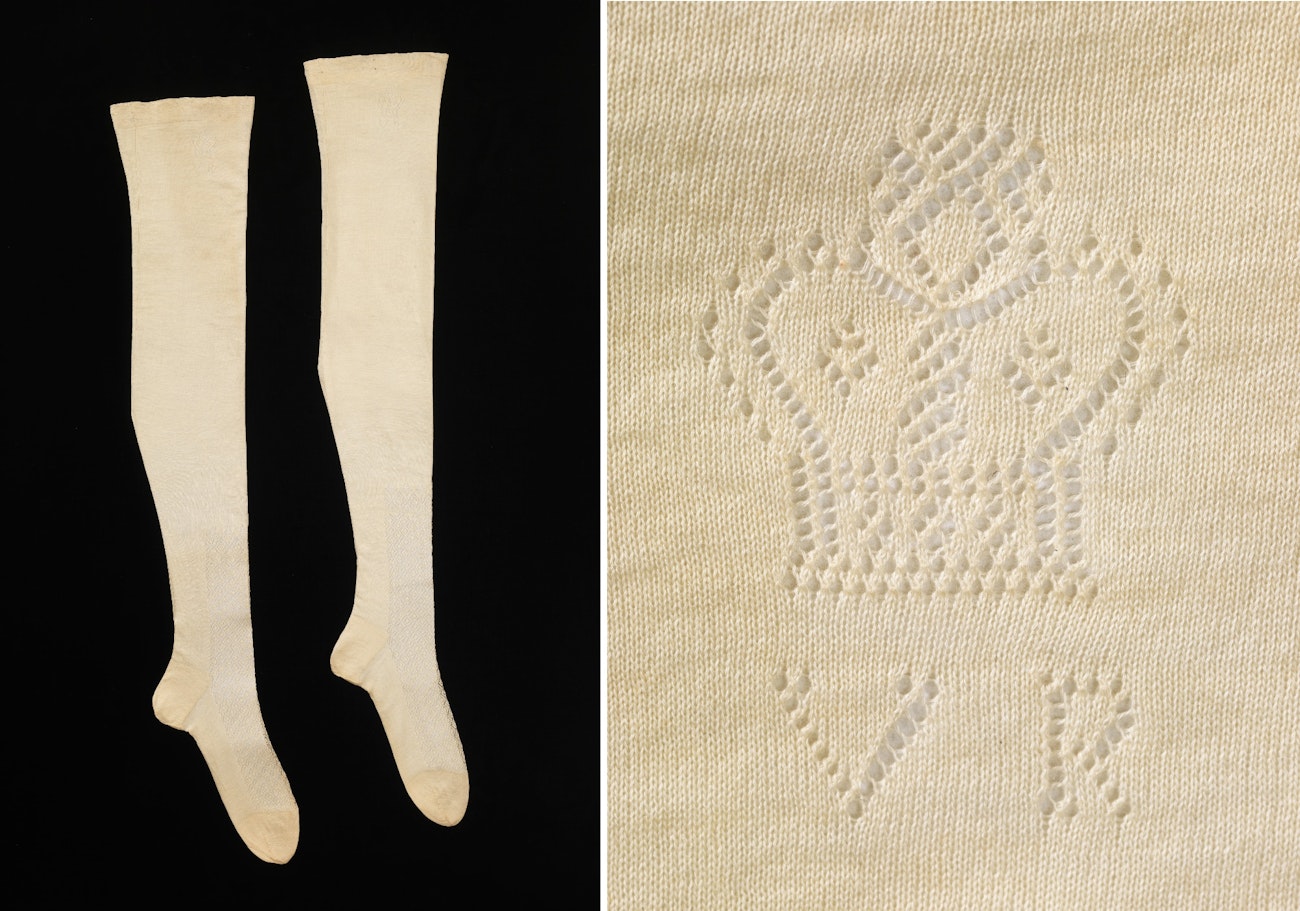The entire population of nineteenth century England, from Queen Victoria downward, wore knitted stockings. Despite the development of long trousers, socks were still an essential garment for men. Many stockings and socks were made by machine, but a large number were still handknitted. The latter were sometimes seen as better, and more likely to last, if they were well constructed. Knitting stockings was seen as a useful way for the poor to earn some money; it was something that could easily be done on a pick-up and put-down basis and thus could be combined with other tasks.
The expansion of education in England in the nineteenth century meant that increasing numbers of children were attending school, and “plain work,” which included knitting, was one of the topics they learned. Often, the pupils were taught to knit stockings, an everyday necessity as well as a marketable skill for future income. Books were produced to assist those who planned to teach knitting.
In England and Wales, the 1870 Education Act made schooling compulsory for all, and knitting was part of the curriculum for girls.
Noblesse Oblige
Ladies from the local area also began to go into the schools to help with these needlework lessons. The records of Weston School in Hertfordshire, for example, occasionally show the daughter-in-law of a village gentleman teaching knitting to the school’s children in the 1870s. Mrs. Lewis in Wools and How to Use Them (Birmingham, 1884) wrote directly to ladies who were visiting schools and assisting the teachers with needlework lessons, including by helping the pupils develop their knitting skills. She devoted a whole chapter to encouraging ladies “with abundant leisure” to perform these “good works.” This included details of what the lady should wear (an apron with pockets) and the tools that she needed (scissors, pencil, extra needles, crochet hook for picking up dropped stitches, and emery paper for removing any rust from needles), as well as a suggestion to encourage knitting by paying proficient students to make items for others. She recommended that the lady have a book for teaching and adhere to the instructions in that book so the pupils’ learning would be consistent—although she stops short of recommending her own book on the subject: Directions for Knitting Socks and Stockings: Revised, Enlarged, and Specially Adapted for Use in Elementary Schools (London, 1883).
Training Teachers
Many writers of the time took an admonitory tone, stressing the advantages of children being able to knit, ensuring that they would not commit the sin of idleness. In Directions for Knitting Socks and Stockings, Mrs. Lewis wrote that teaching girls to knit gave them a desire to do “work” in their spare time. Needlework was a vital skill.
The London School Board appointed Louisa Floyer (1830–1909) as their first needlework examiner. She was a noted promoter of needlework in schools, founded the London Institute for the advancement of Plain Needlework, and wrote several textbooks on the subject, and she claimed that knitting and needlework taught many virtues, including cleanliness, obedience, and concentration.
The Knitting Teacher’s Assistant: Designed for Use of National Girls’ Schools (London, 1817) is the earliest known of such books and was so popular that it went into many editions throughout the century. The “advertisement,” as the foreword was titled, explains that the book’s chief object was to enable teachers of classes to explain properly the art of knitting, “for however simple the art may seem, it has often been observed that little Teachers [sic] have a difficulty in expressing the meaning of their instructions to their pupils.” This suggests that the older pupils were helping the younger ones to learn, following the Madras and monitorial systems of teaching developed by Dr. Andrew Bell and Joseph Lancaster, respectively, which were applied in many schools in the nineteenth century.
The book focused on knit stockings and socks and taught through a series of questions and answers plus a “scale” of the number of rounds and stitches needed for each size. The 1877 edition, which was edited by E. M. C. (Elvina M. Corbould [1849–1936]), stated that the book had “kept its place for about fifty years, [which] proves that it has answered a general want.” By then, 42,000 copies had been produced. The 1881 printing includes an additional “Scale of Measurement” in inches.
 Stocking and sock instructions in the form of a scale from The Knitting Teacher’s Assistant: Designed for Use of National Girls’ Schools (London, 1877). Photo courtesy of author
Stocking and sock instructions in the form of a scale from The Knitting Teacher’s Assistant: Designed for Use of National Girls’ Schools (London, 1877). Photo courtesy of author
Another book, Instructions on Needle-Work and Knitting as Derived from the Practice of the Central School of the National Society (London, 1832), gives us details about the process of teaching different types of needlework in the Central School of the National Society at Westminster. One mistress supervised the work of the teacher, who was aided by three assistant teachers. The knitting instructions are for creating stockings and are given as straight text, with a “scale” of the numbers of stitches and rows for the different sizes and also a small sample knitted stocking attached onto one of the following pages. The copies of this book now held at the Victoria and Albert Museum and in the British Library still have this sample.
Other books for knitting teachers were published through the century. Directions for Plain Knitting for the Working Classes and Schools (London, 1846) by R. J. C. (Rachel Jane Catlow) concentrates on stocking knitting and includes instructions for a few other items as well as a poem extolling the virtues of learning to knit. The plain needlework volume of the Finchley Manuals of Industry published in London in 1852 has instructions on stocking knitting as well as brief instructions for other items. The book is also notable for introductory remarks that mention the desirability of all poor women being able to knit, for knitted stockings were far more durable than bought ones, and that “fancy knitting may frequently be turned to pecuniary profit.”
Teaching Strategies
E. A. Curtis and M. C. G. published their patterns on cards. The individual cards of Curtis’s Self-Help Needlework and Knitting Cards (London, 1884) are 6 inches high by 4⅜ inches wide (about 15 × 11.5 cm): the directions for their use suggest that each girl gets a copy of a card, and the whole class reads it out, thus minimizing the teacher’s work, which in turn “creates a spirit of self-reliance and promotes accuracy.” M. C. G.’s Directions for Knitting Stockings (3rd ed.: Cirencester, 1884) consists of a mix of scale cards and sheets of instructions that could be purchased either as a full set for one shilling, or individually. This arrangement also suggests that each knitter probably had individual instructions.
Once education had become compulsory with the 1870 Education Act, some books detailed the proficiency and skill girls were expected to have, often including at least part of the curriculum. The Standard Guide to Knitting According to the New Code was written by “a lady manager” (1870, London); the second edition (London, 1879) begins its knitting instructions by explaining how to knit stockings and socks, before going on to detail what each of the different stages [grades] would be expected to learn: for the infants and the first girls’ stages, the book suggested knitting garter-stitch strips, which could then be sewn together to make items such as dusters and towels; in the second girls’ stage, they could continue with strips or make wristlets; and in the remaining four stages, the girls knitted stockings of increasing complexity.
 Left: A pair of fine cotton stockings believed to have belonged to Queen Victoria, circa 1875–99. Photo courtesy of the Metropolitan Museum of Art, New York. Right: Detail of the stockings showing the openwork royal cipher made up of a crown and the initials of her name and title, Victoria Regina. Photo courtesy of the Metropolitan Museum of Art, New York
Left: A pair of fine cotton stockings believed to have belonged to Queen Victoria, circa 1875–99. Photo courtesy of the Metropolitan Museum of Art, New York. Right: Detail of the stockings showing the openwork royal cipher made up of a crown and the initials of her name and title, Victoria Regina. Photo courtesy of the Metropolitan Museum of Art, New York
In Plain Knitting and Mending in Six Standards (London, 1876), Louisa Floyer details the knitted items children of different ages should make. Those between five and nine years old knitted garter-stitch rectangles, which were turned into assorted items. At nine, they could make socks, and then at twelve, they would learn more complex items.
Mrs. A. Hibbert, in her book Instructions for the Knitting Frames (London, 1887), argued against the strategy of teaching knitting by simply instructing the children to make garter-stitch strips, claiming that it was boring for “babies” to be churning these out when they could make a specific item on knitting frames, which they would find much more interesting. As she sold such frames and advertised them in her books, she cannot be described as unbiased, even if her opinion might well have been correct.
In 1885, Henrietta Warleigh (1841–1921) produced The Warleigh Musical Drill, which provided a harmonized musical accompaniment to the drill of knitting and purling stitches. Alice Morrow’s Needlework and Knitting Drills for Infants (London, 1900) also included songs that were to be used when pupils were learning to knit: one wonders if she were inspired by Warleigh’s pamphlet.
Knitting as a Trade
Although the vast majority of these books were aimed at those teaching children to knit, a very few also indicate that there was a need to teach knitting to some adults. M. C. G. subtitles her collection of pattern cards Directions for Knitting Stockings from the early 1880s “for the Use of Schools, Mothers’ Meetings and Women in Their Own Homes.” Part II of The Industrial Handbook Containing Plain Instructions in Needlework and Knitting (London, 1856) suggests that it was intended to be used not only by mothers and schoolmistresses, but also by matrons on emigrant ships. The first part of the book consists of basic knitting processes, followed by patterns for stockings and gloves. Later, there is a section on fancy knitting, a skill that the author commends as a reward for industriousness, and which could also be used to create items that might provide an income in the future; this includes patterns for lace edgings.
These nineteenth-century books reveal that teaching knitting was a skill that could be taught—and needed to be taught, as it was essential enough to everyday life to be part of a compulsory curriculum. The widespread use of instructions to knit stockings during this period reflects how essential handknit ones were seen to be and how the poor were expected to be able to make them.
Interested in reading more about education? This article and others can be found in the Spring 2023 issue of PieceWork.
Also, remember that if you are an active subscriber to PieceWork magazine, you have unlimited access to previous issues, including Spring 2023. See our help center for the step-by-step process on how to access them.
Resources
The full text of several of the books mentioned in this article, including The Knitting Teacher’s Assistant and The Standard Guide to Knitting According to the New Code, can be found online at archive.org/details/victorianknittingmanuals.
Lesley O’Connell Edwards lives in Worcestershire, UK, with her two cats and one husband. She contributed to the Holy Hands research project, examining knitted liturgical gloves; details of the project can be found at www.kemeresearch.com. Her other research interests include stocking knitting in sixteenth-century England and working handknitters.

